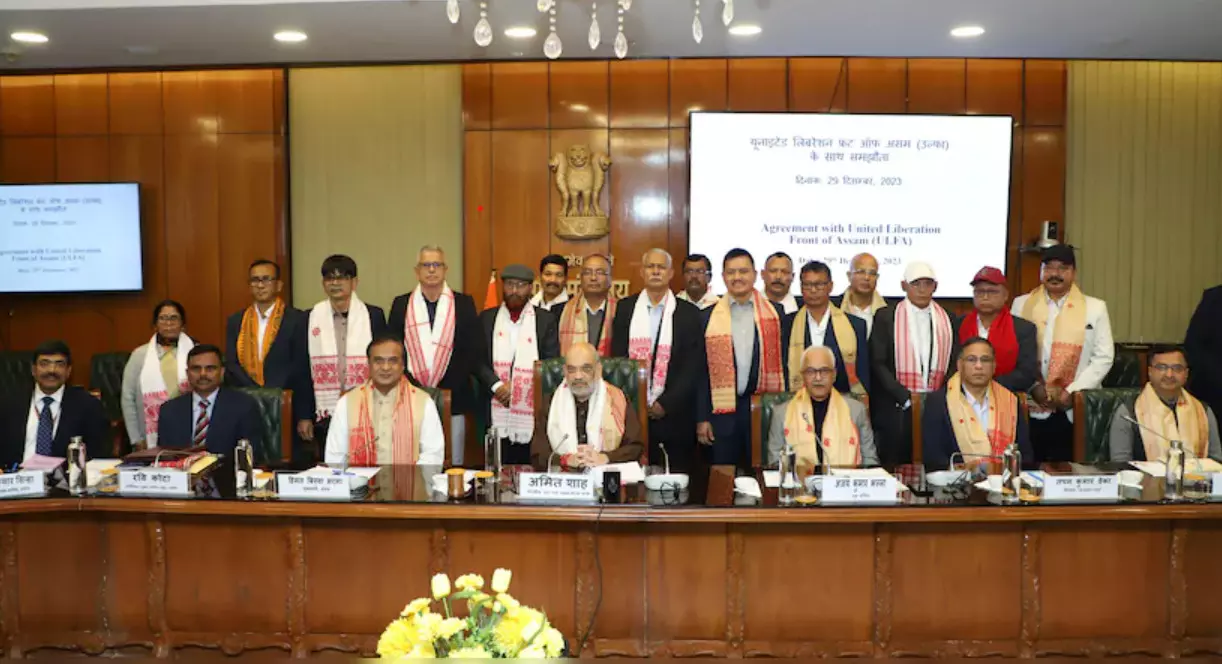On a fragile trail?

As the political climate in India simmers in anticipation of the upcoming General Elections, the BJP-led central government, along with the Assam government, proudly touts yet another 'historic' peace talks with the United Liberation Front of Asom (ULFA). A familiar narrative unfolds, echoing past promises of peace that, regrettably, have yielded little progress on the turbulent grounds of Assam. The timing of this latest agreement raises eyebrows, with critics questioning its political expediency and the tangible impact it may have on the longstanding conflict. The roots of the ULFA insurgency stretch back to 1979 when the group emerged in Assam, fervently advocating for an independent sovereign state named ‘Asom’ for the Assamese people. What began as a response to perceived neglect and exploitation by the Indian government soon transformed into a militant movement. The ensuing decades witnessed a grim tableau of violence, including bombings, assassinations, and kidnappings, plunging Assam into a protracted and bloody conflict. The ULFA's influence grew exponentially, extending its reach to neighbouring countries such as Bangladesh, Pakistan, China, and Bhutan. By the mid-1990s, its extensive network ranked only second to the notorious Liberation Tigers of Tamil Eelam (LTTE) in South Asia. Amidst this escalation, the 1990s saw two pivotal developments — an organised attempt to establish peace talks with the insurgent outfit and signs of internal divisions within the ULFA regarding engagement in talks. One notable military campaign, Operation Bajrang in the early 1990s, proscribed the ULFA and dismantled its scattered camps throughout the state. However, it fell short of curbing the group's expansion and sustainability. Subsequent efforts in 2005-06 led to a temporary 40-day truce, but the fragile accord collapsed, reigniting hostilities. In a surprising turn in 2008, a faction of the ULFA declared a unilateral ceasefire, opening the door to negotiations and marking a significant development in the conflict. By 2011, the once formidable ULFA had weakened, growing more amenable to peace talks. Prime Minister Manmohan Singh's decisive actions around 2005 played a crucial role in turning the tide against the militant group. However, when Narendra Modi assumed office, the government, sensing a dominant position, strategically delayed engagement to gain bargaining leverage. Now, on the precipice of yet another peace agreement, questions loom large. The current political landscape, marked by the BJP's diminishing hold in southern India, suggests that the ruling party is eager to fortify support in other regions ahead of the General Elections. The timing of the peace talks, therefore, becomes crucial, raising concerns about the sincerity and efficacy of the accord. However, despite the cloud of uncertainty enveloping past peace talks, there are reasons for cautious optimism about the recent agreement. The divided ULFA, weakened in its strongholds, now faces a formidable central force. The group's once robust presence has been watered down, providing an opportunity for the government to assert control and influence the trajectory of the conflict. However, the scepticism surrounding the agreement cannot be ignored. History has taught us that 'historic' peace accords often falter in the face of complex realities on the ground. The political motivations behind the timing of this agreement beg scrutiny, and the true impact on the people of Assam remains uncertain. As the nation watches, hopeful but wary, the success of this latest peace agreement will be measured not just in lofty political rhetoric but in tangible improvements in the lives of the people of Assam. The wounds of the past run deep, and only time will reveal whether this 'historic' accord will be a genuine catalyst for lasting peace or merely another chapter in a long and painful saga. At the same time, it is up to the people of Assam, especially the youth, to defy the trends of violence and engage in constructive activities that will boost employment and economy in the state.



